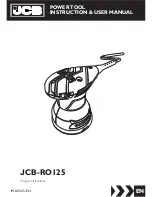
10
6.0
Mains connection
Mains connection and any extension cords used must
comply with applicable regulations.
The mains voltage must comply with the information
on the machine licence plate.
The mains connection must have a
10 A surge‐proof fuse.
Only use power cords marked H07RN‐F
Connections and repairs to the electrical equipment
may only be carried out by qualified electricians.
7.0
Adjustments
Disconnect sander from power
source, before making adjustments.
7.1
Rubber shields
Refer to Figures 9 and 10.
Front and rear rubber shields are connected at top by
hook‐and‐loop fasteners. Peel off top of shield to
access spindle area (Figure 9).
Figure 9: front shield
IMPORTANT: Before tilting table to maximum degree
forward, move top of shield from upper position (A) to
lower position (B).
Figure 10: rear shield
7.2
Table tilt for bevel sanding
Refer to Figures 11 and 12.
1.
Loosen both knobs (A, Figure 11)
counterclockwise.
To tilt forward (45‐degree maximum):
2.
Move table by hand to desired angle shown on
scale (B). Scale is marked in 5‐degree increments.
3.
Retighten knobs (A).
To tilt backward (15‐degree maximum):
4.
Pull out pin (C) and rotate it 90‐degrees to keep it
disengaged.
5.
Tilt table to desired position, and tighten knobs
(A).
Figure 11: table tilt
Figure 12: table tilt
7.2.1
Setting 90‐ and 45‐degree stops
Tools required
:
machinist square
13mm wrench
Refer to Figures 11 through 13.
1.
Make sure table insert has been leveled with table
(sect. 6.7).
2.
Make sure pin (C) is re‐engaged to contact stop
screw. Position table at zero (90‐degrees) against
stop screw (D).
3.
Place square on table and against front of drum or
spindle (Figure 13).











































